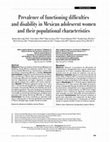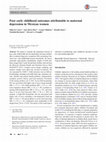Papers by Filipa de Castro
Psychometric properties of a culture-adapted
Neuropsychiatrie de l'Enfance et de l'Adolescence, 2012

International Journal of Environmental Research and Public Health
Background: Lead can affect early childhood development (ECD) differentially due to nutritional d... more Background: Lead can affect early childhood development (ECD) differentially due to nutritional deficiencies that lead to stunted growth, defined as being at least two standard deviations below the average height-for-age. These deficiencies are more frequent among children living in rural locations or with lower socioeconomic status (SES); however, studies at a population level are scarce worldwide. Early childhood development plays a crucial role in influencing a child’s health and wellbeing throughout life. Therefore, the aim of this study was to analyze how stunted growth can modify the association between lead exposure and ECD in children from disadvantaged communities. Methods: Data were analyzed from the 2018 National Health and Nutrition Survey in localities with fewer than 100,000 inhabitants in Mexico (ENSANUT-100K). Capillary blood lead (BPb) levels were measured using a LeadCare II device and dichotomized as detectable (cutoff point ≥ 3.3 µg/dL) and non-detectable. As a m...
Journal of Adolescent Health
Salud Publica De Mexico, Aug 14, 2017
Child labor and severe functioning difficulties and disability in Mexican children and adolescent... more Child labor and severe functioning difficulties and disability in Mexican children and adolescents 5-17 years of age.

Salud Pública de México, 2019
Objetivo. Comparar coberturas de vacunación en niños de 12-23 y 24-35 meses de edad de localidade... more Objetivo. Comparar coberturas de vacunación en niños de 12-23 y 24-35 meses de edad de localidades menores de 100 000 habitantes en México, entre 2012 (Encuesta Nacional de Salud y Nutrición [Ensanut] 2012) y 2018 (Ensanut 100k). Material y métodos. Estimación de coberturas con ambas encuestas. Resultados. Entre 2012 y 2018, se mantuvo la cobertura del Esquema básico, con comprobante y autorreporte, en niños de 12-23 (51.6 vs. 60.2%) y 24-35 meses (51.4 vs. 50.0%), y sólo con comprobante (53.9 vs. 51.3% y 52.8 vs. 44.2%). Se mantuvo la cobertura del Esquema básico más refuerzos en niños de 24-35 meses, comprobante y autorreporte (30.9 vs. 34.0%) y sólo con comprobante (30.2 vs. 27.8%). Disminuyeron las coberturas con segunda y tercera dosis de hepatitis B en niños de 12-23 y 24-35 meses, y con primera dosis de triple viral (SRP) y tercera de pentavalente en niños de 24-35 meses. Conclusiones. Se mantuvieron las coberturas del Esquema básico y Esquema básico más refuerzos aunque dis...

Journal of Child and Family Studies, 2017
Epidemiological evidence linking early childhood development (ECD) with family care behaviors is ... more Epidemiological evidence linking early childhood development (ECD) with family care behaviors is limited. This study assessed relationships of ECD with family care behaviors and child nutritional status in 77,315 children 36–59 months from 26 low- and middle-income countries from the Multiple Cluster Indicator Surveys round 4. We used UNICEF-recommended indicators for literacy–numeracy and learning development. Family care behaviors measured were provision of books and play materials, inadequate care, activities of adult caregivers with child, father’s involvement, attendance to early childhood education program, and violent discipline. Nutritional status was measured by height-for-age z-scores. Three-level linear mixed-model regression analysis was done separately for each ECD outcome. Both developmental domains were associated with family care behaviors, with strongest associations between literacy–numeracy and program attendance, provision of books, and stimulating activities. Differences in the proportion on track for literacy–numeracy were 0.176–0.277 for these three family care behaviors. The multivariable model controlling for maternal education and wealth showed that children with provision of books, program attendance, and four stimulating activities had a proportion of being on track for literac–numeracy that was 0.427 higher than children without these. Higher height-for-age was associated with higher prevalence of being on track for literacy–numeracy and learning development. This study provides epidemiological evidence on the importance of family care behaviors for ECD. ECD could be substantially fostered by interventions that promote appropriate family care behaviors and resources for learning stimulation even in contexts of socioeconomic and educational disadvantage.

The Lancet, 2016
Background Child and maternal health outcomes have notably improved in Mexico since 1990, whereas... more Background Child and maternal health outcomes have notably improved in Mexico since 1990, whereas rising adult mortality rates defy traditional epidemiological transition models in which decreased death rates occur across all ages. These trends suggest Mexico is experiencing a more complex, dissonant health transition than historically observed. Enduring inequalities between states further emphasise the need for more detailed health assessments over time. The Global Burden of Diseases, Injuries, and Risk Factors Study 2013 (GBD 2013) provides the comprehensive, comparable framework through which such national and subnational analyses can occur. This study off ers a statelevel quantifi cation of disease burden and risk factor attribution in Mexico for the fi rst time. Methods We extracted data from GBD 2013 to assess mortality, causes of death, years of life lost (YLLs), years lived with disability (YLDs), disability-adjusted life-years (DALYs), and healthy life expectancy (HALE) in Mexico and its 32 states, along with eight comparator countries in the Americas. States were grouped by Marginalisation Index scores to compare subnational burden along a socioeconomic dimension. We split extracted data by state and applied GBD methods to generate estimates of burden, and attributable burden due to behavioural, metabolic, and environmental or occupational risks. We present results for 306 causes, 2337 sequelae, and 79 risk factors. Findings From 1990 to 2013, life expectancy from birth in Mexico increased by 3•4 years (95% uncertainty interval 3•1-3•8), from 72•1 years (71•8-72•3) to 75•5 years (75•3-75•7), and these gains were more pronounced in states with high marginalisation. Nationally, age-standardised death rates fell 13•3% (11•9-14•6%) since 1990, but statelevel reductions for all-cause mortality varied and gaps between life expectancy and years lived in full health, as measured by HALE, widened in several states. Progress in women's life expectancy exceeded that of men, in whom negligible improvements were observed since 2000. For many states, this trend corresponded with rising YLL rates from interpersonal violence and chronic kidney disease. Nationally, age-standardised YLL rates for diarrhoeal diseases and protein-energy malnutrition markedly decreased, ranking Mexico well above comparator countries. However, amid Mexico's progress against communicable diseases, chronic kidney disease burden rapidly climbed, with agestandardised YLL and DALY rates increasing more than 130% by 2013. For women, DALY rates from breast cancer also increased since 1990, rising 12•1% (4•6-23•1%). In 2013, the leading fi ve causes of DALYs were diabetes, ischaemic heart disease, chronic kidney disease, low back and neck pain, and depressive disorders; the latter three were not among the leading fi ve causes in 1990, further underscoring Mexico's rapid epidemiological transition. Leading risk factors for disease burden in 1990, such as undernutrition, were replaced by high fasting plasma glucose and high body-mass index by 2013. Attributable burden due to dietary risks also increased, accounting for more than 10% of DALYs in 2013. Interpretation Mexico achieved sizeable reductions in burden due to several causes, such as diarrhoeal diseases, and risks factors, such as undernutrition and poor sanitation, which were mainly associated with maternal and child health interventions. Yet rising adult mortality rates from chronic kidney disease, diabetes, cirrhosis, and, since 2000, interpersonal violence drove deteriorating health outcomes, particularly in men. Although state inequalities from communicable diseases narrowed over time, non-communicable diseases and injury burdens varied markedly at local levels. The dissonance with which Mexico and its 32 states are experiencing epidemiological transitions might

PLOS ONE, 2021
Background Childhood is considered the most important phase of human development; within it the p... more Background Childhood is considered the most important phase of human development; within it the period from birth to 5 years of age is particularly critical, given the speed at which changes occur. The context where children live can influence early childhood developmnent (ECD) by providing or limiting opportunities to learn, play and establish social interactions. This study explored the associations between characteristics of the urban environment and ECD in 2,194 children aged 36 to 59 months living in urban municipalities in Mexico Methods We obtained ECD information from the 2015 Survey of Boys, Girls, and Women (ENIM, for its Spanish acronym), measured with the Early Childhood Development Index. The urban environment was evaluated at the municipal level, considering variables from five environment domains: physical, social, service, socioeconomic, and governance. Multilevel logistic models were fitted to assess the association between urban environment characteristics and the ...

The Journal of Primary Prevention, 2020
Adolescent pregnancy is considered a priority public health issue because of its implications in ... more Adolescent pregnancy is considered a priority public health issue because of its implications in the lives of young mothers, their children, and the well-being of the general population. In this paper, we describe an intervention targeting adolescents (aged 11–19 years old) in a rural context and estimate its impact on key outcomes relevant to early pregnancy prevention: knowledge and self-efficacy concerning sexual and reproductive health, knowledge of sexual and reproductive rights, and attitudes toward gender roles. Our study used a quasi-experimental design comprising 747 adolescents. Three difference-in-differences models (raw, adjusted, and by exposure level) with fixed effects estimated the changes in all outcome measures. Our results showed that the intervention community had a significant improvement in all outcomes, and this improvement was larger in those who received the highest-exposure level of intervention compared to a control community. Our study provides evidence that a community-based intervention, founded on comprehensive sexual education, is a promising approach to improve key outcomes related to early pregnancy in rural contexts. Further research should be undertaken to test how similar strategies focusing on multi-layer early pregnancy determinants work on other sub-groups of vulnerable adolescents, such as school dropouts or those living in disadvantaged circumstances.

The Journal of adolescent health : official publication of the Society for Adolescent Medicine, Jan 18, 2017
We aimed to evaluate adolescent access to contraceptive information and quality of care in a samp... more We aimed to evaluate adolescent access to contraceptive information and quality of care in a sample of primary care clinics and pharmacies in Mexico and their association with health facility and adolescent characteristics. We selected a random sample of pharmacies (n = 434) and public-sector, primary care clinics (n = 327) in Mexico City to be visited by young women posing as "mystery clients" looking for contraception or emergency contraception. Access to contraception information was measured as the percent of times that women received the information they requested. To assess quality of care, we built an "adolescent-friendly services" (AFS) score based on the World Health Organization framework. Regression models were fitted to evaluate the associations between outcomes and health facility and client characteristics. Twenty percent of women did not receive the information they requested. Clients seeking emergency contraception information had higher odds of o...
Salud Pública de México, 2017
Severe functional difficulties and disabilities in children and adolescents and the Sustainable D... more Severe functional difficulties and disabilities in children and adolescents and the Sustainable Development Goals.

Salud Pública de México, 2017
Objective. Report prevalence of functioning difficulties and disabilities among Mexican adolescen... more Objective. Report prevalence of functioning difficulties and disabilities among Mexican adolescent women 15-17 years old and identify differences in characteristics of those with and without a functioning difficulty or disability Materials and methods. Using data from the National Survey of Boys, Girls and Women in Mexico 2015 we estimated prevalence of functioning difficulties and disability and used chi square tests for independence and logistic regression to explore associations between this condition and various characteristics. Results. Of Mexican adolescent women 15-17 years old, 11.1% had a functioning difficulty or disability. The group of domains of functioning difficulty and disability with by far the highest prevalence was socio-emotional and behavioral functioning difficulties or disability with 8.6%. Being employed, rural residence and self-reported depression symptoms were associated with having functioning difficulties or disability. Conclusions. This survey constitu...
Salud Pública de México, 2017
Child labor and severe functioning difficulties and disability in Mexican children and adolescent... more Child labor and severe functioning difficulties and disability in Mexican children and adolescents 5-17 years of age.
Salud Pública de México, 2017
Population profiles associated with severe functioning difficulties and disability among two to f... more Population profiles associated with severe functioning difficulties and disability among two to four years old children in Mexico.

Salud Pública de México, 2013
Objetivo. Ofrecer evidencia actualizada sobre inicio de vida sexual y uso de anticonceptivos en m... more Objetivo. Ofrecer evidencia actualizada sobre inicio de vida sexual y uso de anticonceptivos en mujeres adolescentes y adultas en México por grupos de edad, lugar de residencia y estado civil. Material y métodos. Se analizaron datos de las ENSANUT 2006 y 2012, sobre conocimientos y uso de anticoncepción. Resultados. En 2012, 31.2% de las adolescentes (15-19 años) había iniciado vida sexual; el uso del condón aumentó de 31.8 a 47.8% entre 2006 y 2012. El 47.9% de 30 a 34 años y 53.2% de 35 a 49 años reportaron no haber usado anticonceptivo en su última relación sexual. En las áreas rurales se reporta menor uso de anticonceptivos en la última relación sexual. Un alto porcentaje no optó por anticonceptivo postevento obstétrico: 52% (15-19 años), 44.2% (20-29 años), 42.5% (30-34 años) y 39% (≥35 años). Conclusiones. Se requieren políticas equitativas que promuevan el uso de anticonceptivos, particularmente en el periodo postevento obstétrico.

Archives of women's mental health, Aug 10, 2017
We aimed to estimate the population fraction of poor early child health and developmental outcome... more We aimed to estimate the population fraction of poor early child health and developmental outcomes attributable to maternal depressive symptoms (DS) contrasting it between low- and middle/high-income households. We used a nationally representative probabilistic sample of 4240 children younger than 5 years old and their mothers, derived from the Mexican National Health and Nutrition Survey Data (ENSANUT 2012). Complex survey design, sampling, and analytic weights were taken into account in analyses. DS was measured by CESD-7. Child outcomes were as follows: breastfeeding, attending well-child check-ups, respiratory disease, diarrhea and general health problems, immunization, accidents, growth, obesity, and food insecurity. Prevalence of DS among mothers was 21.36%. In low-SES households, DS was associated with higher risk of never being breastfed (RR = 1.77; p < .05), health problems (RR = 1.37; p < .05), acute respiratory disease (RR = 1.51; p < .05), accidents requiring ch...

Salud Pública de México, 2017
Para mejorar las prácticas de lactancia materna es necesario fortalecer acciones de promoción, pr... more Para mejorar las prácticas de lactancia materna es necesario fortalecer acciones de promoción, protección y apoyo, y establecer una política nacional multisectorial que incluya elementos indispensables de diseño, implementación, monitoreo y evaluación de programas y políticas públicas, financiamiento para acciones e investigación, desarrollo de abogacía y voluntad política, y promoción de la lactancia materna, todo coordinado por un nivel central. Recientemente, México ha iniciado un proceso de reformas conducentes a la conformación de una Estrategia Nacional de Lactancia Materna (ENLM). Esta estrategia es el resultado de la disponibilidad de evidencia científica sobre los beneficios de la lactancia materna en la salud de la población y el desarrollo de capital humano así como de los datos alarmantes de su deterioro. La implementación integral de una ENLM que incluya el establecimiento de un Comité Nacional Operativo, coordinación intra e intersectorial de acciones, establecimiento ...

PLOS ONE, 2017
Objective Adolescents need sexual and reproductive health services but little is known about qual... more Objective Adolescents need sexual and reproductive health services but little is known about qualityof-care in lower-and middle-income countries where most of the world's adolescents reside. Quality-of-care has important implications as lower quality may be linked to higher unplanned pregnancy and sexually transmitted infection rates. This study sought to generate evidence about quality-of-care in public sexual and reproductive health services for adolescents. Methods This cross-sectional study had a complex, probabilistic, stratified sampling design, representative at the national, regional and rural/urban level in Mexico, collecting provider questionnaires at 505 primary care units in 2012. A sexual and reproductive quality-of-healthcare index was defined and multinomial logistic regression was utilized in 2015. Results At the national level 13.9% (95%CI: 6.9-26.0) of healthcare units provide low quality, 68.6% (95%CI: 58.4-77.3) medium quality and 17.5% (95%CI: 11.9-25.0) high quality reproductive healthcare services to adolescents. Urban or metropolitan primary care units were at least 10 times more likely to provide high quality care than those in rural areas. Units with a space specifically for counseling adolescents were at least 8 times more likely to provide high quality care. Ministry of Health clinics provided the lowest quality of service, while those from Social Security for the Underserved provided the best.











Uploads
Papers by Filipa de Castro